The cinematographers of Dune, Belfast, Tick, Tick… Boom!, Spencer, Cyrano and The French Dispatch share tales from the sets of their awards-contending productions.
Directors and their cinematographers continue to find themselves limited to minimal crews, PPE protocols and remote grading and colour-correction collaborations in the face of the ongoing Covid‑19 pandemic. As ever, inventive solutions abound.
Haris Zambarloukos’s single-camera shoot on Kenneth Branagh’s Belfast gave his pared-down crew opportunities to advance their positions with work experience upgrades, while Seamus McGarvey’s predominantly Italian crew on Joe Wright’s Cyrano survived blizzard conditions and five weeks of night shoots. Despite production challenges, location shoots remained paramount as ever, as seen in Denis Villeneuve’s Dune, where Greig Fraser captured majestic imagery in remote, rocky locales in Jordan, which brilliantly served the epic adventure’s narrative.
Mixing and matching aspect ratios, lenses and stock remains in vogue. Claire Mathon pushed boundaries with zoom lenses while shooting on Super 16mm and 35mm for Pablo Larrain’s Spencer, while Alice Brooks embraced large-format cameras and anamorphic lenses to capture the struggles of a New York composer in Lin-Manuel Miranda’s Tick, Tick… Boom!. Likewise, Wes Anderson and Robert Yeoman altered framing, colouring and lensing for The French Dispatch.
Diversity in front of and behind the camera remains a high priority for the industry, while the fallout continues from the accidental shooting of cinematographer Halyna Hutchins on the set of Rust last year. Safety on set, as McGarvey observes, needs to sit firmly at the top of every production’s agenda.
Greig Fraser - Dune
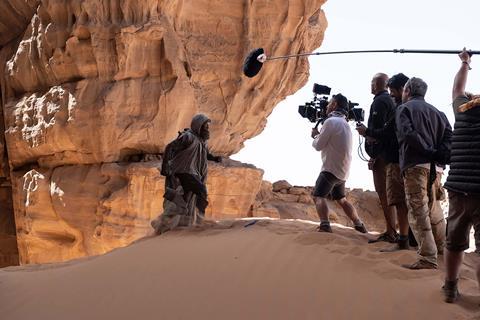
Cinematographer Greig Fraser’s work spans large-scale features such as Rogue One: A Star Wars Story and the upcoming The Batman to smaller projects such as Lion, which saw him nominated for an Oscar and Bafta. On Dune, his first feature with writer/director Denis Villeneuve, Fraser made the decision to scale back and utilise natural light and resources — particularly when filming in Jordan’s desert landscape.
Fraser is renowned in the industry for creating the immersive LED studio backdrop, known as the Volume, that was used to film Disney+ series The Mandalorian. And on Dune, he used a creative shooting process that converted digital images to film and back again, while also interchanging film formats to contrast intimacy and scale, humanity and isolation. Fraser and Villeneuve are working on Dune: Part Two, seeking to retain its signature style while bringing further invention to the sequel.
Roger Deakins was DoP on Denis Villeneuve’s Blade Runner 2049. How did you follow his work?
One thing I love about cinematographers is we’re all very encouraging of each other, and Roger is my hero. Denis and I first met at a barbecue at Roger’s house. I’ve been on cloud nine ever since he asked me to work with him. I don’t think there’s a single piece of intellectual property he loves more than Dune, so I took it very seriously to be entrusted to create the visuals for his imagination.
What was the goal in shooting digitally and then transferring the work to film?
For Dune, we shot it with a traditional digital camera, the Arri Alexa LF [large-format] using Panavision H series and Ultra Vista lenses. Once the visual effects were in, we effectively filmed out the file onto a piece of negative. You then scan the negative back in and grade. What you’ve done is create an analogue film. It doesn’t replace originating on film [but] for anyone who might misunderstand the process as being a poor man’s film origination, it’s not. It’s something I’ve never seen before. We tried lots of different processes and this one stood out — it replicated Denis’s vision of the desert and its heat and brightness. The process added a depth and substance to the image.
How did you approach Dune’s simple lighting?
When you’re in the studio you start from nothing, you have to create the basis of light. In the desert, Mother Nature rewards us with her power. So then it becomes a case of taking light away and diffusing it. Between the camera, Denis and the actors, there’s this beautiful triangle of simplicity that allows the performances to shine through. My goal is to not let technical get in the way of actors. So we chose locations and shot at certain times of the day with the sun as backlight — it’s classic filmmaking.
Did you use the Volume while on the Origo stages in Budapest?
Over the last five years, I set up The Mandalorian with Lucasfilm. I’ve been like a scientist inventing medicine — and I had to take the medicine before anybody else could use it. It was incredibly stressful. I couldn’t just hand that over to somebody else, I had to set the rules. And then I headed on to Dune. The LED technology was in its early stages. We used a little bit of it on Dune, but not in filming scenes. For lighting interiors, we had a great team that created solid stone, sand-painted panels with an intricate set-up that allowed a sun path into the studio, lighting the sand that was the same colour as the sand from Jordan [where the production shot exteriors]. Filming for the interiors of the ornithopter took place on a hill outside of Budapest where the sun hit a screen and bounced into the cockpit. We were creative in mimicking natural light.
What new technology do you have your eye on?
I am working on some film-related projects and some VR projects. I think there’s huge changes ahead. More work is going to be done in the Volume — its backgrounds are getting more real-time. You can change the lighting of the background on set now too — previously you had to bake it, render it. Also, 3D gaming engines for games and films are going to coalesce and converge.
What effect has the death of Halyna Hutchins had on the cinematography community?
What it has done is highlight that we all need to have safety in mind. The people in my sphere have always been respectful. But everyone can be more vigilant. We’re passionate people, however at some point we need to take a step back and see the forest for the trees.
Haris Zambarloukos - Belfast
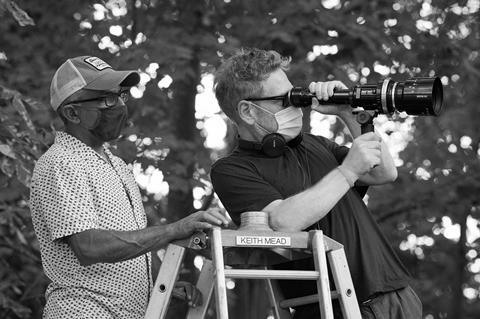
Cypriot cinematographer Haris Zambarloukos frequently collaborates with director Kenneth Branagh, having worked on Sleuth, Thor, Murder On The Orient Express and the upcoming Death On The Nile. The pair, who received Camerimage’s cinematographer-director duo award in 2017, created the intimate black‑and-white imagery for Belfast, Branagh’s autobiographical story of his youth in the Northern Ireland city during the rise of sectarian violence in the late 1960s. Shooting handheld in the close spaces of recreated working-class houses and narrow streets, with minimal artificial lighting, was driven partly by pandemic concerns and also by Branagh’s personal reflections on his childhood.
How did you navigate the challenges of the Covid-19 pandemic on the Belfast shoot?
We shot in August 2020, as soon as we were allowed to start filming. It was pre-vaccinations, and so our challenges were huge. We shot as much as we could in Belfast, then we went back to [England] and shot at a disused school. It was ours to turn into a mini studio. We also used Farnborough Airport since it was shut down. We built the exterior facade of this one boxed-in street. We got four streets out of one thanks to production designer — and miracle worker — Jim Clay.
What Covid-19 safety protocols did you adhere to?
We had a very pared-down crew and cast. We had one camera and I did the operating, aside from certain days when Andrei Austin, the Steadicam operator, came in.
Why did you decide to shoot largely in black and white?
Ken and I have always used black and white and colour. For us, it’s part of the language of filmmaking. Ken uses the word forensic — it strips back the unnecessary and focuses on the essence of things. For me, it has something removed from our everyday reality, black and white is clear enough to be precise yet abstract enough to be emotive.
How did you approach the lighting in the film?
The lighting was almost nothing. I wanted it to be as unobtrusive as possible, so you really see the performances. It was mostly key light and practicals. I lit the scenes I had to: the interior of the cinema and the theatre, and the bus scene with Judi Dench and young Jude [Hill]. It’s what we call a poor-man’s process: back projections and screens in a stationary bus.
This is the first film that you and Kenneth Branagh have filmed together on digital. What camera did you use?
We used the [Arri] Alexa Mini LF with a colour sensor. Whether film or digital, I like to shoot in colour because in the DI [digital intermediate] process, I can make a more accurate black-and-white image.
Were vintage lenses also important to you?
The Alexa Mini LF is groundbreaking — the sensor is now bigger on medium-format cameras, and that allows you to use some of the large-format lenses. So we used the Panavision System 65 lenses and some of the Spheros. There are very few of the System 65s: they are sharp in a certain band and they go soft towards the edges. They are from the 1980s, and what Ken used back when he made Hamlet [in 1996]. The Sphero lenses are from the David Lean period when [cinematographer] Freddie Young did Lawrence Of Arabia, Doctor Zhivago and Ryan’s Daughter. I wanted to see how they would look in a 1.85:1 ratio and they fared really well.
What is it like working with Kenneth Branagh on set?
Ken has always been someone that works what we call French hours: a 10-hour day, with a shorter lunch. You get to go home and see your family and you can think about what you have to do the next day. On set, he will go to every department and say, “Please, let’s be inclusive.” Sometimes it’s hard because you have personal relationships with crew members that go back many years but we all have to do it together.
One of our operators created this fantastic database of UK-based women in the film industry. So when we were doing our testing for Death On The Nile, we tried people out, and hired several fantastic female electricians. Someone once gave me an opportunity; the best way to say thank you is to do the same.
Alice Brooks - Tick, Tick… Boom!

Former child actress Alice Brooks was won over by cinematography at age 15 while watching camera teams on film and television sets. A graduate of USC School of Cinematic Arts, her cinematography résumé includes web series The Walking Dead: Red Machete and musical In The Heights, the film adaptation of Lin-Manuel Miranda’s stage show (which he wrote before Hamilton) directed by fellow USC grad Jon M Chu. She followed that up with another film musical collaboration: Miranda’s own feature-
directing debut Tick, Tick…Boom!, which centres on struggling composer Jonathan Larson (played by Andrew Garfield) before he created the successful rock musical Rent. Brooks took inspiration from her own experience growing up in a small New York apartment with artists including her playwright father and theatre actress mother.
You worked on In The Heights, and immediately after Tick, Tick… Boom!. How was that?
On the last day of filming In The Heights in August 2019, Lin gave me the script for Tick, Tick… Boom!. We began shooting in March 2020 for eight days, before we shut down for six months [due to the pandemic]. It was heartbreaking. We started ‘Tick, Tick… Zooms!’ with the entire cast and crew, which was an amazing bonding experience. We started shooting a second time at Steiner Studios in September [2020] for 42 days. Netflix’s [Covid-19] safety protocols were unbelievable. I realised I was safer on set than anywhere else.
What were your references?
When I read the script, I thought these could be scenes from my childhood. Like Jonathan [Larson], we always had friends around, and it was the middle of the Aids epidemic so we lost friends too. The look-book I presented to Lin had pictures of my family, and since we’re the same age, we shared similar memories of growing up in New York. The blurred lines between dreams and reality became our jumping-off point.
Did you have access to any of Jonathan’s possessions?
All of the artwork in the apartment belonged to Jonathan. The keyboard was his, and Andrew wore a blue flannel shirt that was his. The apartment is almost a direct replica as well, and we filmed exteriors of his tenement building that still stands on Greenwich Street in the West Village. We wanted to honour Jonathan in the most real way possible. The ‘No More’ sequence was captured in the stairwell of his actual apartment building.
The look of the film veers between vivid and muted colours. How did you achieve this?
We decided to sew in hints of musical theatre via colour, like little Easter eggs. We have a Cabaret number, so we did that in pink. At the end, on the wall, there are hints of red that come in and out — that foreshadows Rent. In terms of overall tone, we wanted the colours to be subtle. Sometimes [Larson’s] reality is bleak, so we had the blue pop out slightly. Sometimes you’re in his fantasy, or it’s Sunday at the diner with sunlight streaming in. We overexposed those scenes so they felt a bit painterly.
What camera and lenses did you use?
I worked with the Panavision DXL2 digital camera that has a large-format sensor with G Series Anamorphic prime lenses. Dan Sasaki (VP of optical engineering) at Panavision and I worked to create our recipe for the lens — to age it and make it feel more time-period correct with appealing distortions.
Are you seeing more women in camera and lighting departments?
There have always been women but the fact women are now finding success is encouraging. I used to be the only woman in a [location] scout family. I have so many photos of me and the guys behind me. On Tick, Tick… Boom! it was the opposite: diversity is in Lin’s DNA. He supports all different backgrounds, races, genders and socioeconomic backgrounds. Sometimes he was the only guy in the scout van.
What are you working on next?
I am shooting Wicked with Jon Chu at Sky Studios in Elstree [the first production to use the new stages at the studio]. So I’m excited.
Claire Mathon - Spencer
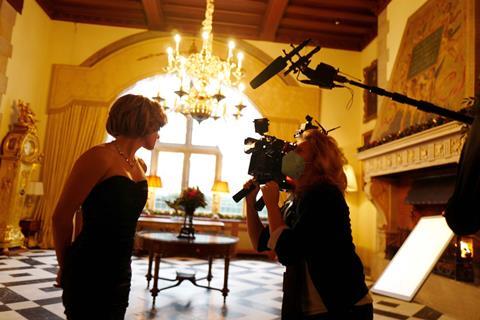
French cinematographer Claire Mathon first gained international attention for her work on Mati Diop’s Atlantics and Céline Sciamma’s Portrait Of A Lady On Fire. The latter saw her win the best cinematography prize at the 2020 Cesar Awards, and she has recently completed work on Alice Diop’s narrative feature debut Saint-Omer. In Chilean director Pablo Larrain’s Spencer, Mathon fuses vibrant hues with contrasting soft, natural light to portray a vulnerable Princess Diana (Kristen Stewart) over Christmas at the royal family’s Sandringham Estate while still married to Prince Charles. Mathon chose to film predominantly on Super 16mm, with the darker night scenes on 35mm. She worked within a 1.66:1 aspect ratio in order to stay faithful to Super 16mm and add to “the fable’s visual storytelling and haunted tone”. Intimate handheld camerawork and short focal lenses were also used to highlight the princess’s claustrophobic, suffocating environment.
You chose to shoot on Kodak in Super 16mm and 35mm. What creative and logistical challenges did this pose?
Pablo had shot in these film formats before so we were well aware of the logistical constraints. I had a special link with the rushes calibrator at the laboratory Hiventy in Paris. I received photograms at lunchtime the next day so I could react quickly to any possible issues. It was a daily joy to shoot on film. It forces one to watch [scenes] with the naked eye, and to rely less on monitor screens. Pablo and I also often rejoiced in the colours it produced, so beautiful and vibrant.
How did you achieve the soft yet vibrant quality in the lighting and colours?
The smoothness of the image and the colours is due to the choices of the S16 [Arri 416 Super 16mm] lens, and the way of calibrating it. I did not use filters. The quality of the light is also essential, combined with the make-up for Kristen’s skin tone. I liked working with lamps in the background, which I chose for their softness and colour. I tried to recreate this quality of light by being mobile and following Kristen as closely as possible. In post, I worked on this texture combining softness without being grey. I kept the richness of the colours and accentuated this kind of luminous aura around Kristen’s character, which is almost spectral and contributes to the haunting story of the film.
Did you and Pablo Larrain have a set of guidelines as to how you would film Kristen Stewart?
From our first discussions, Pablo wanted to physically be close to her with very short focal lengths. We experimented with Kristen to define this distance — the focal lengths that we liked [such as 8mm and 9.5mm], which created tension between the camera and her. We also defined the way to move with her, or around her. The camera follows her, stalks her, observes her and also accompanies her torments. We also tried to capture her interiority, so that the camera struggles with her, but also watches her struggle with these long travelling shots or Steadicam shots. Pablo’s staging is often very choreographed and precise, particularly in the rhythm of the camera movements.
What were your visual research and references for Princess Diana and the royal family?
I reviewed many period photographs of Diana. Some [photos] where she poses with her boys accompanied me throughout filming. Yorgos Lanthimos’s The Favourite was also a key inspiration, as were films by Stanley Kubrick such as Barry Lyndon and A Clockwork Orange, which inspired Pablo’s staging. Painting is always present in my research — here, portraits and landscapes for the hunting scene. But it is ultimately the various tests shot with Pablo that I believe allowed me to understand and approach the images of the film.
Filming took place from January to March 2021. What restrictions did you have with the pandemic?
We were forced to quarantine, and therefore we had to have many discussions virtually. Pablo was unable to come to the calibration, which took place in Berlin. I regretted that this moment, which often brings the cinematographer and the director together around the finished film, had to take place at a distance and with quite a substantial time difference between us. [Finally,] I was not able to return home to see my family for a long period between preparation and the extended shooting schedule.
Cinematography is often highlighted for its lack of female representation. Do you see that changing anytime soon?
It is changing, but slowly. We are talking about it and are aware of the lack of female representation at the head of DoP teams. I’m happy to see female cinematographers who recently worked on important international films such as Ari Wegner (The Power Of The Dog) and Caroline Champetier (Annette), among others.
Seamus McGarvey - Cyrano
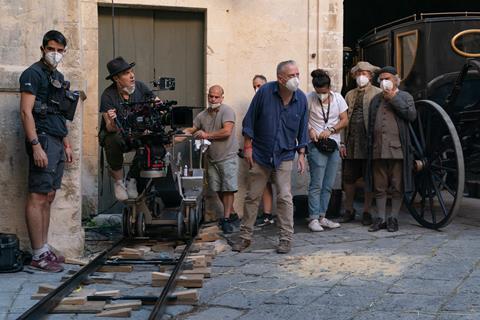
Seamus McGarvey takes a traditional approach to filming, arguing that the fundamentals of creating an image lie not in the pixels or sensor size but in the mood, light and focus. His sixth film with Joe Wright, Cyrano is a modern musical based on Erica Schmidt’s stage play starring Peter Dinklage and Haley Bennett. The Oscar-nominated DoP utilised minimal equipment and natural light on the Sicily set, where he faced strict Covid-19 protocols, five weeks of night shoots and a volcanic eruption on Mount Etna.
How was the experience of filming Cyrano in lockdown?
Italy was in total lockdown. I couldn’t go from Sicily back to my home in Tuscany. There were no tourists. Most of the crew was Italian, and everyone got tested every day. We wore masks and we didn’t go out at night. We built sets outside for scenes with more performers, such as the theatre, and we had fewer extras. We knew we would be safe, and it provided a focus. It felt like a Cyrano campus, a creative boot camp. The mayor was very helpful to us as well; he allowed the town [Noto] to be used as a backlot.
You shot in real locations, transforming Sicily into France. What were your lighting set-ups like?
We didn’t have huge lighting set-ups. We tried to find ways to get light into places, and to work with smaller sources within — like flames, candles and LED torches. We also picked the most optimal times to shoot.
Were the battle scenes on Mount Etna particularly challenging?
I have PTSD thinking about it! It was December, and we were assured it never snows until the end of January. We built a set on top of the volcano, with a platform that held a large technocrane. It snowed a week before we were supposed to shoot. There was no time to rescout so we reconceived the battle sequences at 8,000 feet instead of 16,000. We were a little army marooned up there on Mount Etna. It was freezing cold, and it was very thin air to carry gear. Everything had to be shot on a tripod because conditions were so slippery. The cave in the film was built the day before shooting to create a weather cover. Just as we completed filming, a volcano erupted. A day or two later our set was unrecognisable, because lava had covered it.
What lenses and cameras did you choose for Cyrano?
We used the Arri Alexa LF camera and Leitz Leica LF lenses for their absolute clarity — you can’t look away, they are so crisp with a lovely shallow depth of field. At the start, we put 10-denier Christian Dior stockings on the back of the lens. When you see candles, they create a chromatic star-shaped effect. When that became too overt, we switched the diffusion to a glimmer glass. With the war scenes, we shot all filtration.
How technical is your approach when it comes to shooting with digital cameras?
When we shot on film, I was pretty adroit at that. With digital, I have no clue. If you said to me, “What’s the resolution or pixel size or sensor size?”, I would look blank. I have great people around me. Moving towards very complex digital capture has actually released me from the camera. I focus on the lenses and the important stuff: what’s in front of you, what’s the mood, what’s the story and what you do with light, colour, camera movement and depth of field — all of the attributes open to us as cinematographers.
Do you think new safety rules will be implemented following the death of cinematographer Halyna Hutchins on set?
More films are being made and more people are required to make the films. Budgets are there, yet I think there is a gold rush feeling with the industry and corners are being cut. People are being asked to work longer hours, which I am conscious of. Employ the right people, give them the right money, let them work proper hours with a break. This has been an ongoing problem; we need to take the bull by the horns.
Robert Yeoman - The French Dispatch
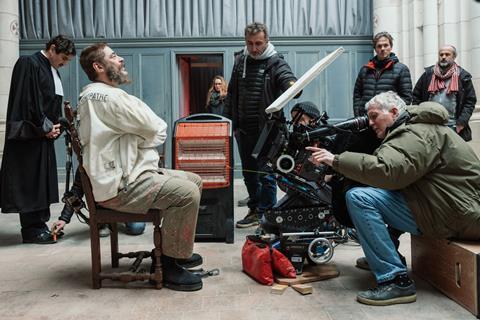
A regular collaborator with Wes Anderson since the filmmaker’s debut Bottle Rocket (1996), Robert Yeoman relishes the challenge of shooting film from a single camera, and employing the precise moves and compositions for which the director is known. On Anderson’s 10th feature The French Dispatch, a homage to journalism by way of an American publication based in a fictional French city, Yeoman worked closely with production designer Adam Stockhausen and costume designer Milena Canonero, varying the use of colour, lighting and framing to create each of the film’s four segmented stories. As filming took place in the French town of Angouleme from late 2018 to March 2019, Yeoman further experimented with 35mm colour and black-and-white film stocks — the latter influenced by Anderson’s love of the French New Wave.
What is the visual process for achieving Wes Anderson’s distinctive style?
Wes has a general idea, he sets the tone. He’s very specific about how he likes things. But we all have a certain amount of freedom to work within his framework. Something he started on Fantastic Mr Fox, Wes does an animatic and it kind of acts as the bare bones of the whole thing. It’s taking that cartoon and turning it into the reality of a film. The challenge we face is the characters in animatics can move faster than people in real life, so we have to adjust things.
What were some of the challenges while working on The French Dispatch?
There was the walk of Jeffrey Wright [who plays journalist Roebuck Wright]. He’s walking through the police station and he goes through all these rooms. We do it in one shot using a very long dolly track with a system that allowed the dolly to move in and out one way and slide off the track sideways. It’s a lot of choreography between camera and actors and lighting.
We also did a lot more of these Towercam shots. There is a shot of the library where the camera comes down to the floor below; we had to put a hole in the ceiling.
I think the lighting on The French Dispatch was a lot more theatrical than we’ve done in the past as well, using gels and LED rigs [Arri SkyPanels].
You have shot film for all of Anderson’s pictures. How was this different?
We shot the colour sequences on 35mm [Kodak Vision3 200T colour negative film 5213], and for the first time, we used black-and-white film stock [Kodak Double-X 5222] for the black-and-white sequences, because of the striking look, grain and contrast. We did a lot of test shoots. The 35mm rushes were processed normally, without any push or pull processing, at film lab Hiventy in Paris. Interesting too, we were shooting digital stills, 4K on digital stills cameras for some of the smaller moving sequences. They had to eventually look like 35mm.
Anderson likes working with just one camera. Does that make it easier for you?
I prefer one camera but most directors like multiple cameras. And I operate the camera, I always have. On this film, I used the Arricam ST and LT cameras, fitted with Cooke S4 prime lenses for the spherical part, when filming the faces; and Arri Master Anamorphics for the wide stuff, allowing us to keep everyone sharp and in the frame. In terms of aspect ratio, we framed most of the action in Academy ratio 1.37:1.
Did you have to work remotely for post-production?
Wes lives in France and England, so he [and editor Andy Weisblum] edited in his little office in Paris. Then he started the colour timing over in London at Company 3. They then sent a version to LA where I screened it. In today’s world, the systems are so sophisticated I’m looking at the exact same thing they are. I send my notes, they make another pass, I make more notes… That’s how it’s done.























No comments yet